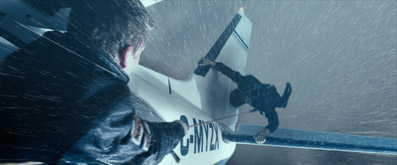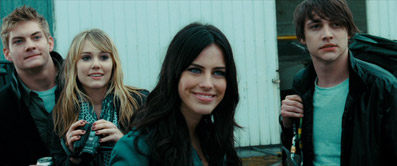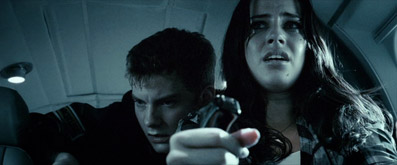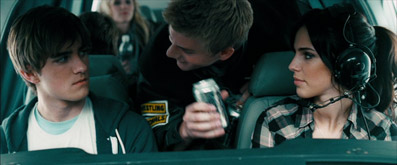|
You want to know how to make airplanes scary to me? Put me inside one and have it take off. I don't like flying. It doesn't make sense. An object the size of a warehouse and heavy enough to squash buildings should not be able to get off the ground at all, let alone climb to a height of thirty thousand feet and stay there. Every time I go up in one of the bloody things I become painfully aware of the fragility of my mortality and that every passing minute might be my last. Statistics repeatedly assure us that it's the safest way to travel, but if your train hops its tracks or your boat hits a whale then there's at least a half decent chance you'll get out of it alive. When a plane falls out of the sky, the likelihood that you'll get to practice that life jacket demonstration you ignored before takeoff is pretty damned slim. And trains don't bounce through turbulence or rattle around like a shopping trolley careering down a steep grassy hill when they pass through a storm. Oh yeah, I just love flying.

Given my antipathy to air travel or any sort, you'd think that any wannabe thriller that takes place on a plane would be off to a great start, but it just ain't the case. It's flying I hate, not the vehicles that do it, so watching them on screen holds no specific terrors. Unless they're filled with large scuttling spiders, of course. I empathise with film characters who themselves dislike flying, but I can honestly say that I've never seen a film yet that captures the essence of what it FEELS like to suffer at the hands of this particular phobia. Instead they lump this task onto a single character – usually a supporting role with whom the audience has no emotional bond – who sweats, twitches and gibbers to the unfortunate sod in the adjascent seat, and is only there at all to fly into a panic at the worst possible moment. Some while ago I watched an episode of one of those TV docusoaps set in an airport in which a woman who was petrified of flying was steeling herself up for the flight she hoped would help her combat her terror, only at the last minute to unbuckle her seatbelt and flee from the plane in tears, and I felt more for her than all the frightened movie plane passengers in the history of cinema combined. Film directors, I reckon, think flying is brilliant, and those who don't – Stanley Kubrick was one, and look how smart he was – choose not to make films about it.
That said, sticking your characters on a plane and launching them into the sky does temporarily isolate them from the rest of humanity, a concept around which the horror genre orbits. Stephen King understood this only too well when he wrote The Langoliers, and even its iffy TV movie adaptation does rather well on the "what the hell is happening and where has the world gone?" element of its storytelling. It's a setup that's also central to Altitude, a 2010 American mystery-horror in which a group of college friends being flown to a Coldplay concert by one of their number become lost in a storm cloud, where they lose control of the plane and contact with the outside world. Unable to descend and with fuel running low, the plane then comes under attack from a creature that appears to be stalking them from within the clouds.

Altitude is a film that, apart from a handful of festival appearances, has gone straight to DVD in the UK. Actually it did that in the USA too. This doesn't immediately signal that it's a bad movie, but does suggest something about its big screen potential. There is, it has to be said, some interesting and occasionally thoughtful stuff in here, but key elements are borrowed from recognisable sources, and you're also going to have to spend ninety minutes in the company of characters as shallow and annoying as...as...oh hell, as the current American teen horror movie norm.
Leading the pack is Sara, who on emerging from the hanger at the film's post-prologue start, lowers her hood and shakes her hair free in sunlit slow motion like she's landed the starring role in a shampoo commercial, and little she subsequently does or says suggests she has the aptitude for all that much else. She can apparently fly a small dual-prop plane, but despite doing all of the requisite business – pressing a few buttons, pushing a couple of levers and saying aeronautical things to air traffic control – she never really seems like she knows what she's doing. But it's in Sara's blood, you see. She's following in the footsteps of her dear departed mother, who was also a pilot and who in the bleached-out prologue is shown to have died in a mid-air collision. You'd think this would teach Sara some responsibility on the flight deck, but oh dear no. In an impromptu effort to cure the glumly love-sick Bruce of his aerophobia, she abruptly hands the controls over to him, sending the plane into a dive that gets the others screaming. Sara's response is to calmly encourage her petrified friend to level the plane out, only re-taking control when Brucie's inability to do so looks set to kill them all. What a pro.
Accompanying this pair are guitar-wielding Cory – who is uninteresting enough to be marked for possible early death – and film student Mel, who's shooting endless waggly shots on her Canon HDV palmcorder, a device capable of producing high quality HD quality images (I've got one, you see) but whose picture and sound here look like they were captured on a ten year-old mobile phone. Completing the quintet is Mel's boyfriend Sal, and if you're looking for something that could turn even the smoothest flight into a screaming nightmare then he's your man. Sal is the sort of teenage male tosser who could single-handedly put you off ever visiting the States, a loud and infuriating monkey that you can't imagine being friends with anyone human, let alone this lot. He appears to be on board solely to function as a crude antagonist, one whose dopey dialogue and mouthy portrayal (courtesy of the unfortunately named Jake Weary, though I do wonder what first-time feature director Kaare Andrews was thinking here) constantly remind you that you're watching an underwritten low-budget North American horror flick.

Altitude is a film with an identity crisis, a situational thriller that mutates into a monster movie and in the last act transforms abruptly into an episode of The Twilight Zone. Thrown into the mix is an action movie implausibility that sees Cory dangled wildly on the end of a rope from a plane that is flying high enough for ice to have formed on its wings, then attempt to free a jammed aileron by giving it a good kicking. All of which would probably be rather fun if the running time were also that of an early Twilight Zone episode. But the expansion to feature length has upped the importance of character interaction, and in common with so many of its modern American brethren, the dialogue and personal issues are by the teen horror numbers, and scream out for the sort of wit and invention that blessed the best low-budget genre works from the 70s and 80s. It's thus hard to care much for anybody's fate beyond wanting to see Sal dispatched as quickly and messily as inhumanly possible.
There's a technical proficiency that you tend to expect of even a low budget genre film in an age where just about every element can be digitally tweaked. The challenge of shooting almost an entire film in a single small location is certainly well met and the ending wraps things up tidily, despite being freely adapted from one of the more celebrated cult films of recent years. Inevitably, not everyone will be as cynical about the drama and the characters as I. Certainly the person I watched it with – someone with a fondness for watching plastic American teens in peril – rather enjoyed it all, though even she was giggling helpless at Cory's reality-defying airborne dangle. And in spite of my griping, it's hard to really dislike a film whose monster was born of the director's conviction that there's nothing scarier than an anus with shark's teeth.
In a pleasing kick against the current low-budget digital trend, Altitude was shot on 35mm on a Panavision camera and the 2.40:1 anamorphic transfer here makes the best of the results. Although much of the film plays out in the dark of a storm cloud, where light levels are low (a screen grab of the darker scenes is almost impossible to make out, but looks fine on a well calibrated TV screen), colours are drained and shadows are like small black holes, there's never a sense that detail has been sucked away in the process, thanks in no small part to Norm Li's nifty lighting camerawork (to light anything effectively in such a confined space is a skill worthy of attention) and the well-balanced contrast of the transfer itself. Detail is very good for a DVD, something particularly visible on facial close-ups, where even the texture of skin can be clearly made out. Sharpness junkies will be pleased to know that the film is also being released on Blu-ray, so you can get a really good look at those teenage pores.

You can choose between Dolby 2.0 stereo or 5.1 surround and I'd go for the latter every time. Both are clear with good frontal separation, but the range, LFE punch, and a lively and occasionally spectacular use of the full sound stage puts the surround track far ahead of its stereo brother.
Commentary with director Kaare Andrews
The voice of young American filmmaking enthusiasm provides a rather engaging and certainly informative guide to how the film came about, how individual sequences were shot and how some of the effects were achieved. Andrews also provides some detail on the cast, the equipment used and his own background as a comic book artist, plus some interesting anecdotes about the shoot itself. Unsurprisingly he's enthusiastic about the finished film, but the expected "I love this..." comments are kept to a bare minimum and he's not above commenting on things he's not happy with or problems he encountered in the course of the production. On the whole a solid companion to the film.
Altitude: Behind the Scenes (47:03)
An extended EPK in which behind-the-scenes footage is cut with interviews with the cast and crew in which they enthuse wildly about the project and each other. The length does allow some interesting detail on how the project came together, on the shooting of specific scenes and the special effects, but you'll have to wade through a sea of superlatives and mutual admiration to get to it.
Green Storm Featurette (9:41)
It's always interesting to see effects shots before they've been composited, and there are plenty to glance through here, though a side-by-side comparison with the finished result would have been nice. Kaare Andrews is on the soundtrack providing helpful detail on what we are watching.
Original Concept Gallery (4:00)
A rolling gallery of original concept artwork and storyboards, most if not all of which were drawn by director Andrews.
Finally we have the Trailer (1:47), a fast-paced sell that reveals the monster.
A breezy fantasy-horror-suspense work whose effectiveness will depend on your tolerance for annoying North American movie teens, sparkle-free dialogue, familiar character arcs and a schizophrenic approach to genre identity. It certainly has its fans, but despite my best efforts and the guarded enthusiasm of my viewing companion, I'm just not one of them. No problems with Anchor Bay's DVD however, which sports a solid transfer and a decent bag of extras.
|